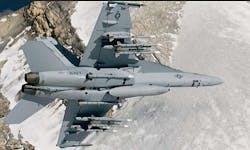Boeing, Lockheed-Martin to start full-scale development of infrared search sensor for F/A-18E/F combat aircraft
The passive IRST sensor system provides on-board situational awareness for Super Hornet pilots while detecting, identifying, and attacking enemy targets at long ranges. The system's high-angle detection capability also helps combat pilots track closely spaced enemy aircraft at long ranges.
The F/A-18 E/F IRST uses a passive longwave infrared sensor that detects the heat from the engines of potentially hostile aircraft or missiles within its large field of view, Lockheed Martin officials explain. Since the IRST emits no electronic signals, it can detect and track enemy aircraft and missiles without switching on the host aircraft's radar, which risks giving away its presence to the enemy.
The F/A-18E/F IRST, which is mounted in the forward section of the aircraft's centerline fuel tank, feeds target track file data to the Super Hornet's mission computer with while providing infrared imagery to cockpit displays.
The system consists of a sensor head that houses a three-axis inertially stabilized gimbal that scans the optics and detector assembly; a commercial off-the-shelf (COTS) processor; high density digital recorder; and air-to-liquid heat exchanger.
The Boeing and Lockheed Martin IRST team will do the work on the EMD phase of the contract in St. Louis; Orlando, Fla.; Santa Ana, Calif.; and Irvine, Calif., and should be finished in September 2015.
For more information contact Boeing Defense, Space & Security online at www.boeing.com/bds; Lockheed Martin Missiles and Fire Control at www.lockheedmartin.com/mfc, or Naval Air Systems Command at www.navair.navy.mil.
Related stories
-- Infrared Search and Track Sensor (IRST) system hits development milestone;
-- Lockheed Martin developing system requirements for F-15C IRST program; and
-- Infrared search and track system for Navy F/A-18 jet fighter enters full-scale development.
